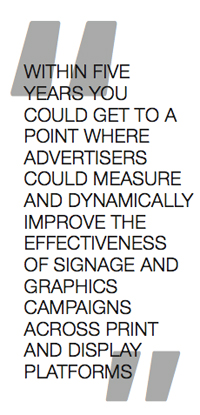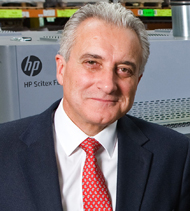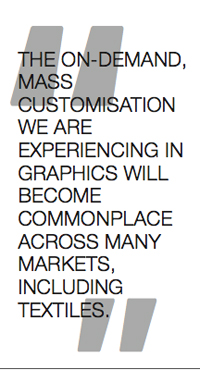We asked the industry: what’s had the biggest effect on the development of the wide-format print sector, and what’s likely to leave the biggest mark going forward?
 Martyn Hicks
Martyn Hicks
President of Fespa UK
As Director of Screenprint Productions for 25 years, and with a background as a printing equipment sales rep. I’d say the biggest impact on the development of the wide-format digital print sector has been the way you can buy machines. Certainly it’s easier for people to get into the marketplace because the print machines themselves have become commodity priced.
Also, as commercial litho and web offset markets have declined, many of those players have moved into wide-format digital, so we’ve seen huge companies sell wide-format print as they would have sold litho and web print, which has really driven down print prices.
And in this ‘tightening of the belt’ period, marketers have looked at print in a new way and pushed for versioned POP/POS materials, which has led to shorted runs and driven through work to wide-format digital. But it’s also meant that the print producers have had to invest in that versioning capability. Moving forward I think marketers will continue to push this versioning demand.
I think we’ve also got to be mindful of the relationship between the PSP and the machine manufacturer because, increasingly, on-board diagnostics and other various software modules mean manufactures know exactly what a machine’s usage is, what it’s ink consumption is etc. They can use that information to determine certain pricing etc. and could have a huge impact in determining how the market goes.
 Las Barrow
Las Barrow
President of Fespa
Twenty years ago wide-format meant screenprinting, and a very few large litho presses. Now, when one thinks wide-format one thinks digital. During this headlong advance the technology has evolved, suffered revolutions and now settled into a series of advanced and robust printing processes. Digital challenged, then surpassed four-colour screen process, and is now challenging the quality of offset printing.
Digital wide-format has also allowed for larger sizes and a wider range of substrates. This in turn has expanded the market for print.
In the future, speed and quality will improve further and costs reduce; allowing more and more production to be converted to digital. Yet the real challenge and opportunity doesn’t lie in this conversion but in continuing to find new and exciting markets. Personalisation will be key. This isn’t about putting a name on a wall but giving interior designers and consumers the opportunity to exercise their imagination.
 Tim Greene
Tim Greene
Director of Wide-Format Printing, InfoTrends
There are a couple of important things going on that will impact on wide-format. In summary, it’s about data, how it is used and how it is presented. There are converging technologies that indicate where signage and graphics are going in the retail and outdoor advertising markets: tracking technologies that use mobile phone tracking to tell store planners exactly where shoppers go and where they stop; smart signage technology that allows stores to track which shoppers look at signs and for how long; facial recognition technology that identifies all of the demographics of the shoppers and passers-by.

Combine these with the concept of that advertisers and brand marketers want two things, to deliver promotional messages to their intended audience, and to do that as cost effectively as they can. Connect all those and, within five years you easily could get to a point where, on an individualised basis, advertisers could measure and dynamically improve the effectiveness of signage and graphics campaigns across print and display platforms. What you get is the need for wide- format producers to collect and use data as part of their service offering.
 Simon Osborne
Simon Osborne
Managing Director, Oasis Graphics
Looking back over the last 20 years, technology has transformed wide-format print in so many ways. The advent of UV printing has enabled us to produce at an overwhelming rate, and advanced cutting tables, like our Zund, mean that we're able to cut and finish at a speed to match. Predicting the future is tricky – technological improvements are a given and we're seeing continuous increases in speed and efficiency, but to go out on a limb I think that we'll see big changes in materials and substrates in response to growing environmental pressures.
 Mark Rowland
Mark Rowland
Regional Business Manager — Greater Western Europe, UK and Ireland, HP Scitex
The transformation of large- format printing has been enabled by rapid developments in printhead, ink and media technologies and increasingly powerful chips to drive Rips that deliver ever-accelerating press speeds and image quality. Combined with new generations of infrastructure, it is possible to store vast quantities of data and develop production-enhancing workflows, management and monitoring systems and remote diagnostics for high-quality, cost-effective, on- demand and profitable printing.
Looking ahead I expect the trends in the next few years to include more targeted runs using versioning; continued migration to digital from screen and flexo; and significant traction in using digital to complement large-format offset. PSPs will also expand their activities with more Web-to- print, logistics and print-pack-and-place services.
In technology, we will see more automation, higher speeds and continuously improving inks and media. We also look forward to new value-adding features like augmented reality (e.g. HP Aurasma) that links printed graphics and signage to the Web, providing greater information and an enhanced customer experience.”
 Noel Palmer
Noel Palmer
Managing Director, PPS
The biggest impact in our sector over the last 20 years has been the ease and cost of printing large-format graphics. When?we first started it was?expensive to get into and hard to produce good results but margins were high. Now it’s just the opposite. This has lead to us developing into more bespoke market sectors by utilising our flatbed combined with different mediums to offer products that have a higher perceived value.
To the future – I think developments in thin OLED screen technology may see an end to the need for printed displays that have to be changed for every new promotion or show. The OLED screen could be available as the overall surface of a conventional pop-up display or roller banner or entire exhibition wall – just switch it on and beam a new image or design from your wristwatch when you get to the show and your away! No need for large format-printers, flatbeds etc., just a totally new and convenient medium!
 Heather Kendle
Heather Kendle
Marketing Director, Inca Digital
There were three things that had a significant impact on the wide-format market over the last 20 years: firstly, the speed and quality of digital wide-format printing made the industry seriously consider digital printing as an alternative to analogue screen production and introduced the potential of commercially viable, short- run customised graphics. Secondly, the introduction of UV inks, alongside solvent and aqueous, gave the market the ability to digitally print vibrant, long-life graphics for outdoor use and expanded the range of applications. Thirdly, the banking crisis sparked by the collapse of Lehmans changed the retail market's investment in wide-format advertising virtually overnight. This, combined with the proliferation of media channels, meant retailers had to develop cleverer and highly tactical POS/POP campaigns. This has resulted in the need for higher volumes of fast turnaround, highly targeted, graphics which in turn benefits digital wide- format firms.
The next 20 years will bring some fantastic developments in digital wide-format printing. We will see even higher speeds and increasing levels of quality. There will be the introduction of new inks and fluids that can be jetted onto a greater variety of materials as well as the introduction of digital machines for even more industrial market applications.
 Tony Cox
Tony Cox
Business Manager, Sun Chemical
The key development in wide format during the last 20 years is undoubtedly the shift from analogue technology to digital. More recently, we’ve seen most of the major Western European and North American equipmentmanufacturers eliminate solvent-based printers from their product ranges and replace them with either UV or water-based technology.
Personalised print opportunities have grown in all geographies and I believe that this will continue to grow in the coming years. Also, UV, water-based and hybrid printers can now offer the balance of properties that could enable PSPs to address other applications, such as packaging and commercial print requiring fast drying, low odour and so on. I am confident that developments in printheads, equipment and of course ink technology will make further diversification a reality for wide-format print businesses.
 Roland Biemans, Marketing and Communications Manager, Hollanders
Roland Biemans, Marketing and Communications Manager, Hollanders
The biggest impact in this industry has been the development in printheads and inkjet technology. Besides this, the key point has been the individualisation of customer; the acceptance of Internet and mobile photography in everyday life has changed how people use social media, webshops and personalised applications. Inkjet technology is perfectly suited to accommodate one-offs.
I think the trend of growth in the textile printing market will only increase too. Not only because of the replacement of vinyl and PVC as part of 'cleaner' and 'greener', but also because many more applications can be produced with dye-sub and disperse direct printing. The next big change will be digital pigment inkjet printing across different media types.
And the possibility to incorporate more printed electronics in existing print production flows will open up new markets and new applications. On one hand, there will be more demand for decentralised printing to accommodate faster turn-around, but at a standardized higher quality level. On the other, there will be the need for greater logistical control to distribute the centralised production of commoditised goods. As cost increases for off-shore production, there will be renewed possibilities for specialised local production.
 Duncan Smith
Duncan Smith
Wide Format Group Director, Canon UK
20 years ago the wide-format industry went through a momentous change as manufacturers and PSPs moved away from using Diazo printing technology for hardcopy reproduction to what we nowknow as plain paper copying. Ever since, wide-format technology and the opportunities it can offer to customers has progressed significantly.
To achieve growth and increased profits PSPs will need to increase volumes, reduce costs or diversify into different markets. I expect PSPs to bring more solutions in-house to enable them to offer additional services. We are likely to also see growing demand from PSPs for software that helps to improve efficiency and maintain consistency of quality.
 Leon Watson, UK General Manager, Spandex
Leon Watson, UK General Manager, Spandex
Twenty years ago a landmark digital product redefined the signmaking business – that was the Gerber Edge. It let signmakers print direct to vinyl for outdoor applications for the first time, something thatwould previously have been the sole preserve of a screenprinter. That machine empowered craft-based businesses to take the digital path and effectively ‘change the sign’ over their own door.
Going forward, I doubt that any single technical revelation will drive the sector on – printers will need to invest across a range of formats and technologies to offer the fullest range of services to their customers. The key factor in the development of the sector will entrepreneurialism and imagination.
 Tudor Morgan, Systems Marketing Manager, FujiFilm Speciality Ink Systems
Tudor Morgan, Systems Marketing Manager, FujiFilm Speciality Ink Systems
Digital technology has dramatically changed the way we interact, and wide-format print has embraced digital inkjet technology, leading to its growth. The success of UVinkjet technology has also improved the production process and opened up new business opportunities – most importantly, in a very cost-effective way.
The next challenge in the wide-format landscape will be the shift to single-pass print technology that will provide even faster throughput, and consequently increased efficiency. There will be further development of hybrid inkjet technology designed specifically to support LED curing systems, and this combination will effectively complement development of single-pass printing systems.
This powerful mix will take inkjet technology outside graphics arts and into industrial print applications – a trend that will significantly change the world we live in to make it extremely visual and print driven.
 Martin Johns
Martin Johns
Market Development Officer, Prographics Epson
 The development of high- quality micropiezo printheads, combined with high-performance wide- gamut inks, has revolutionsed wide-formatprinting. The resultant range of digital printers have transformed the industry and opened up wide-format graphics to photographers, artists, retailers, interior designers, architects and more. What used to be an expensive process available to only a few is now available to the masses and new applications are coming to market all the time.
The development of high- quality micropiezo printheads, combined with high-performance wide- gamut inks, has revolutionsed wide-formatprinting. The resultant range of digital printers have transformed the industry and opened up wide-format graphics to photographers, artists, retailers, interior designers, architects and more. What used to be an expensive process available to only a few is now available to the masses and new applications are coming to market all the time.
There is no doubt we will see further evolution of printheads, like the new Epson PrecisionCore technology. We will see continued progress in speed, quality and flexibility and the miniaturisation of printheads will allow manufacturers to develop new generations of wide-format printers. Plus, new inks and fluids will be introduced enabling digital printing onto a wider variety of materials. I predict that the benefits of on-demand, mass customisation we are experiencing in graphics will become commonplace across many markets, including textiles.
 Sidney Bobb
Sidney Bobb
Chairman, BAPC
Within the large-format sector perhaps the most major impact was when graphic software could be linked to a device that could output in full-colour economically, efficiently and relatively quickly.
Developments in software, inks and substrates over the last 20 years meant almost anything could be printed, which has had a major impact on the industry. And business culture has changed too. Service providers need not only to be good and efficient print producers, but they have also needed to become more aware of how their clients are changing and react accordingly. Not only are customers more sophisticated but their requirements will constantly change and by working in partnership with them print businesses will be able to face those challenges and create satisfaction for those they deal with and some profit for themselves.
{jathumbnail off}



